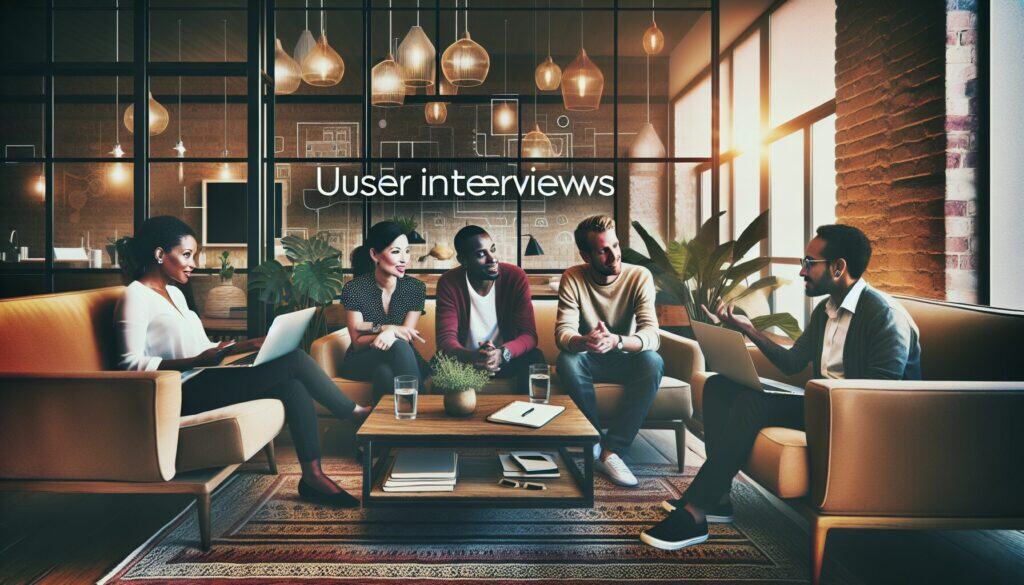Obtenir des informations qualitatives approfondies sur les expériences, les motivations, les besoins, les difficultés et le contexte des utilisateurs d'un produit ou d'un service.
- Méthodologies : Clients et marketing, Économie, Lean Sigma, Fabrication, Gestion de projet, Qualité
Interviews d'utilisateurs

Interviews d'utilisateurs
- Expérience client, Cartographie de l'itinéraire du client, Pensée conceptuelle, Validation de la conception, Conception centrée sur l'humain, Utilisabilité, Tests d'utilisabilité, Expérience utilisateur (UX), User-Centered Design
Objectif :
Comment il est utilisé :
- Il s'agit d'une conversation individuelle au cours de laquelle un chercheur pose des questions ouvertes à un participant représentant le groupe d'utilisateurs cible. Les sessions sont souvent enregistrées et impliquent une écoute active et un approfondissement pour découvrir des informations détaillées.
Avantages
- Permet une compréhension riche et approfondie des perspectives des utilisateurs ; découvre le "pourquoi" des actions des utilisateurs ; développe l'empathie pour les utilisateurs ; est flexible pour explorer des sujets inattendus.
Inconvénients
- La réalisation et l'analyse prennent du temps ; les résultats sont qualitatifs et ne sont pas statistiquement généralisables ; il existe un risque de biais de la part de l'enquêteur ; le recrutement d'un grand nombre de participants peut s'avérer coûteux.
Catégories :
- Clients et marketing, Idéation, Conception de Produits
Idéal pour :
- Comprendre les besoins des utilisateurs, valider les concepts et recueillir des commentaires détaillés sur la facilité d'utilisation et la désirabilité.
Les entretiens avec les utilisateurs jouent un rôle important au cours des premières phases de la conception et du développement d'un produit, en particulier dans des secteurs tels que les logiciels, les biens de consommation, les soins de santé et l'automobile, où il est primordial de comprendre le comportement de l'utilisateur final. La méthodologie implique généralement diverses parties prenantes, notamment des chefs de produit, des concepteurs UX et des chercheurs, qui travaillent en collaboration pour formuler des questions ouvertes qui permettent d'approfondir les expériences des utilisateurs. Ces sessions peuvent se dérouler dans différents contextes, qu'il s'agisse de discussions informelles autour d'un café ou d'environnements structurés, et elles sont généralement enregistrées à des fins d'exactitude. Les informations recueillies lors de ces discussions peuvent éclairer les processus de conception itératifs, contribuer aux tests de convivialité et aider à identifier les points douloureux ou les besoins non satisfaits que les données quantitatives seules ne peuvent pas révéler. Par exemple, les entretiens avec les utilisateurs ont joué un rôle déterminant dans la conception des interfaces de navigation dans les applications mobiles, permettant aux équipes de découvrir les frustrations spécifiques que les utilisateurs peuvent ressentir en termes de présentation, de fonctionnalité et d'accessibilité globale. Ces données qualitatives servent non seulement à valider des hypothèses, mais aussi à stimuler l'innovation en suscitant de nouvelles idées fondées sur les expériences directes des utilisateurs. En tant que méthode flexible, ces entretiens peuvent pivoter en fonction des réponses des participants, ce qui permet de découvrir des domaines d'intérêt inattendus susceptibles de déboucher sur des concepts révolutionnaires. Le fait de s'engager auprès d'utilisateurs réels permet aux équipes de conception de cultiver l'empathie, ce qui garantit que le produit final correspond étroitement aux attentes de l'utilisateur et améliore sa satisfaction. Cette méthodologie s'avère particulièrement efficace dans les cycles de conception itératifs, où des observations répétées peuvent conduire à des améliorations continues jusqu'à ce que le produit soit prêt à être commercialisé. Mener des entretiens avec les utilisateurs dès le début et fréquemment peut également établir une base solide pour des conceptions centrées sur l'utilisateur, attirant ainsi une plus grande acceptation du marché lors du lancement.
Principales étapes de cette méthodologie
- Commencez la séance par une présentation chaleureuse afin d'établir un rapport.
- Posez des questions ouvertes pour encourager les participants à partager librement leurs idées.
- Utilisez des techniques d'écoute active, telles que le hochement de tête et les affirmations verbales.
- Utilisez des questions de suivi et des sondages pour approfondir des réponses spécifiques.
- Prêtez attention aux signaux non verbaux et au langage corporel pour obtenir un contexte supplémentaire.
- Invitez les participants à développer leurs expériences et leurs sentiments.
- Encouragez la narration pour recueillir les expériences et les motivations détaillées des utilisateurs.
- Prévoyez des pauses et des silences pour donner aux participants le temps de réfléchir et de répondre.
- Résumez les points clés de l'entretien pour en vérifier la compréhension et l'exactitude.
- Terminez la session en remerciant les participants et en réitérant la valeur de leur contribution.
Conseils de pro
- Incorporer des techniques ethnographiques en observant les utilisateurs dans leur environnement naturel avant les entretiens afin de contextualiser les résultats.
- Utiliser l'analyse thématique après l'entretien pour identifier des modèles à travers plusieurs sessions, améliorant ainsi la synthèse des données qualitatives.
- Compléter les entretiens par des visites cognitives, permettant aux utilisateurs de verbaliser leur processus de réflexion lorsqu'ils interagissent avec les prototypes.
Lire et comparer plusieurs méthodologies, nous recommandons le
> Référentiel méthodologique étendu <
ainsi que plus de 400 autres méthodologies.
Vos commentaires sur cette méthodologie ou des informations supplémentaires sont les bienvenus sur le site web de la Commission européenne. section des commentaires ci-dessous ↓ , ainsi que toute idée ou lien en rapport avec l'ingénierie.
Contexte historique
1986
(si la date est inconnue ou n'est pas pertinente, par exemple "mécanique des fluides", une estimation arrondie de son émergence notable est fournie)

Articles Similaires
Questionnaires sur les troubles musculo-squelettiques
Tests à plusieurs variables (MVT)
Analyse de régression multiple
Systèmes de capture de mouvement
Méthode MoSCoW
Test de la médiane de Mood